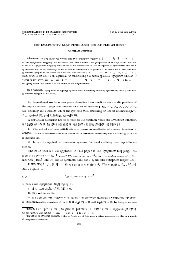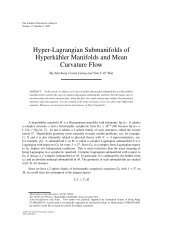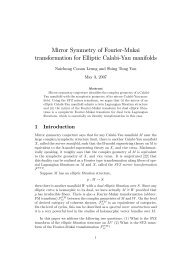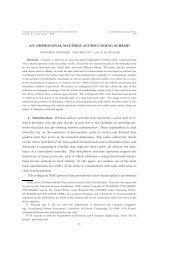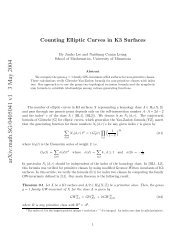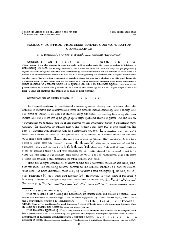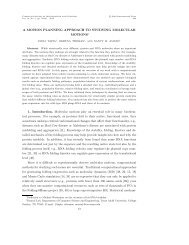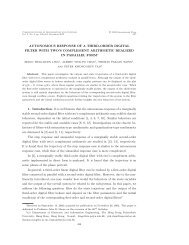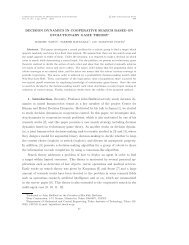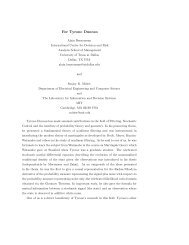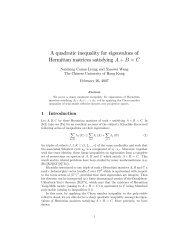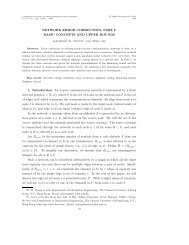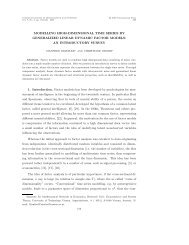AN OPTIMAL DISTRIBUTED ROUTING ALGORITHM USING DUAL ...
AN OPTIMAL DISTRIBUTED ROUTING ALGORITHM USING DUAL ...
AN OPTIMAL DISTRIBUTED ROUTING ALGORITHM USING DUAL ...
You also want an ePaper? Increase the reach of your titles
YUMPU automatically turns print PDFs into web optimized ePapers that Google loves.
282 PUNYASLOK PURKAYASTHA <strong>AN</strong>D JOHN S. BARAS<br />
3. The Single Commodity Problem: Formulation and Analysis. We consider<br />
in this section the single commodity problem, which involves routing of flows<br />
to a common destination node, which we label as d. We restate the problem for this<br />
special case in the following manner:<br />
Problem (B) : Minimize G(F) = ∑<br />
subject to<br />
(i,j)∈L<br />
G ij (F ij ) = ∑<br />
(i,j)∈L<br />
∫ Fij<br />
0<br />
u[D ij (u)] β du,<br />
(5)<br />
(6)<br />
∑<br />
F ij = r i +<br />
∑<br />
F ji , ∀i ∈ N,<br />
j:(i,j)∈L<br />
j:(j,i)∈L<br />
F dj = 0, for (d, j) ∈ L,<br />
with 0 ≤ F ij < C ij , ∀(i, j) ∈ L.<br />
r i is the incoming rate for traffic arriving at node i, and destined for d. The optimization<br />
is over the set of link flow vectors F, whose components are the individual<br />
link flows F ij , (i, j) ∈ L. As usual, equations (5) give the flow balance equations at<br />
every node and equations (6) refer to the fact that once a packet reaches d, it is not<br />
re-routed back into the network.<br />
We use a dual decomposition technique of Bertsekas [1] to develop a distributed<br />
primal-dual algorithm that solves the above-stated optimal routing problem. We carry<br />
out our analysis under the following fairly natural assumptions. These assumptions<br />
are also used, almost verbatim, for the multicommodity version of the problem in<br />
Section 4.<br />
Assumptions:<br />
(A1) D ij (u) is a nondecreasing, continuously differentiable, positive real-valued<br />
function of u, defined over the interval [0, C ij ).<br />
(A2) lim u↑Cij D ij (u) = +∞.<br />
(A3) There exists at least one feasible solution of the primal Problem (B).<br />
Assumption (A1) is a reasonable one, because when the flow u through a link<br />
increases, the average queueing delay (which is a function of the flow u) increases too.<br />
Assumption (A2) is satisfied for most queueing delay models of interest. Assumption<br />
(A3) implies that there exists a link flow pattern in the network such that the incoming<br />
traffic can be accommodated without the flow exceeding the capacity in any link.<br />
We start the analysis by attaching prices (Lagrange multipliers) p i ∈ R, to the<br />
flow balance equations (5) and form the Lagrangian function L(F,p)<br />
L(F,p) = ∑<br />
G ij (F ij ) + ∑ ( ∑<br />
p i<br />
(i,j)∈L i∈N<br />
j:(j,i)∈L<br />
F ji + r i −<br />
∑<br />
F ij<br />
),<br />
j:(i,j)∈L




